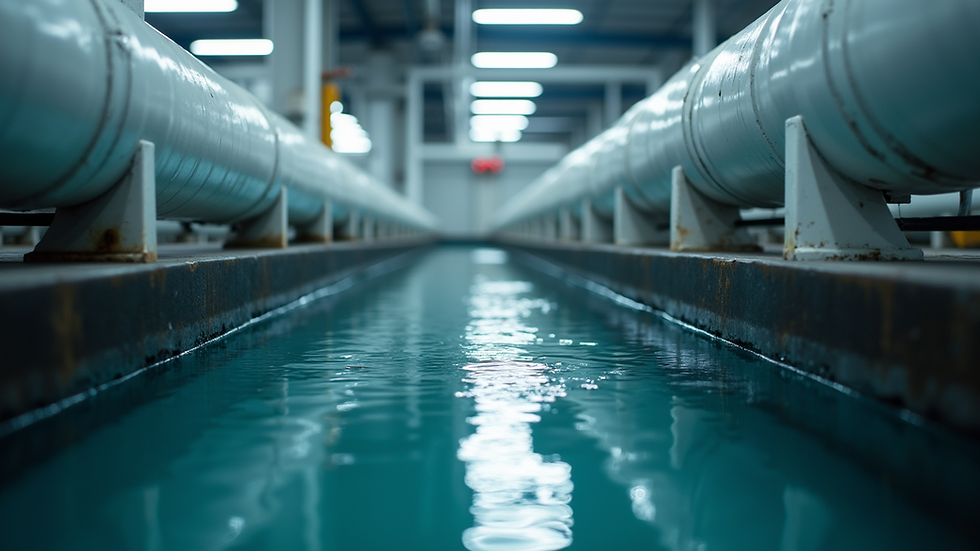Master Industrial Wastewater Management in India
- palwinder kaur
- Aug 30
- 4 min read
Industrial growth in India has been rapid and transformative, contributing significantly to the economy. However, this growth comes with environmental challenges, especially in managing wastewater generated by various industries. Effective industrial water management strategies are essential to ensure sustainable development while protecting water resources. This article explores practical approaches, technologies, and regulatory frameworks that can help industries in India master wastewater management.
Understanding Industrial Water Management Strategies
Industrial water management strategies involve the planning, treatment, and reuse of water used in industrial processes. These strategies aim to minimize water consumption, reduce pollution, and comply with environmental regulations. In India, industries such as textiles, chemicals, pharmaceuticals, and food processing generate large volumes of wastewater that require careful handling.
Key components of industrial water management strategies include:
Water conservation: Implementing measures to reduce water use through efficient processes and recycling.
Wastewater treatment: Using physical, chemical, and biological methods to remove contaminants.
Reuse and recycling: Treating wastewater to a quality suitable for reuse within the industry or for other purposes.
Compliance and monitoring: Adhering to government regulations and continuously monitoring water quality.
Adopting these strategies not only helps industries reduce their environmental footprint but also lowers operational costs by optimizing water use.

Key Industrial Water Management Strategies in India
India faces unique challenges in industrial water management due to its diverse industrial sectors and varying regional water availability. Here are some effective strategies tailored for Indian industries:
1. Source Reduction and Process Optimization
Reducing water use at the source is the most cost-effective strategy. Industries can audit their water consumption and identify areas where water use can be minimized. For example, switching to dry cleaning methods in textile manufacturing or optimizing cooling systems in power plants can significantly reduce water demand.
2. Advanced Treatment Technologies
Employing advanced treatment technologies such as membrane filtration, activated carbon adsorption, and advanced oxidation processes can improve the quality of treated wastewater. These technologies help industries meet stringent discharge standards and enable water reuse.
3. Zero Liquid Discharge (ZLD)
ZLD is an ambitious approach where no liquid waste is discharged from the industry. Instead, all wastewater is treated and recycled, leaving only solid waste. Several Indian industries, especially in the textile and chemical sectors, are adopting ZLD to comply with environmental norms and conserve water.
4. Rainwater Harvesting and Water Recycling
Integrating rainwater harvesting systems with wastewater treatment can supplement water supply and reduce dependency on freshwater sources. Treated wastewater can be reused for non-potable purposes such as irrigation, cooling, and cleaning.
5. Capacity Building and Awareness
Training employees and management on water conservation and treatment practices is crucial. Awareness programs can foster a culture of sustainability within the organization.
6. Regulatory Compliance and Incentives
Industries must stay updated with regulations from bodies like the Central Pollution Control Board (CPCB) and State Pollution Control Boards (SPCBs). Compliance not only avoids penalties but can also open opportunities for government incentives and subsidies for adopting green technologies.
7. Collaboration and Partnerships
Collaborating with technology providers, research institutions, and environmental consultants can help industries access the latest innovations and best practices in water management.

What are the 7 Steps in Wastewater Treatment?
Understanding the wastewater treatment process is essential for implementing effective water management strategies. The typical treatment process involves seven key steps:
Preliminary Treatment
Removal of large solids and debris through screening and grit removal to protect downstream equipment.
Primary Treatment
Sedimentation tanks allow suspended solids to settle, reducing the load on secondary treatment.
Secondary Treatment
Biological treatment using microorganisms to degrade organic pollutants. Common methods include activated sludge and biofilm reactors.
Tertiary Treatment
Advanced treatment to remove remaining nutrients, pathogens, and fine particles. Techniques include filtration, disinfection, and chemical precipitation.
Sludge Treatment
Processing of sludge generated during treatment through thickening, digestion, and dewatering to reduce volume and stabilize waste.
Disinfection
Killing or inactivating pathogens using chlorination, UV radiation, or ozone before discharge or reuse.
Effluent Disposal or Reuse
Treated water is either safely discharged into water bodies or reused within the industry or for other applications.
Each step is critical to ensure that the treated water meets environmental standards and is safe for reuse or discharge.

Practical Recommendations for Indian Industries
To master industrial wastewater management, Indian industries can adopt the following actionable recommendations:
Conduct Water Audits Regularly
Identify water-intensive processes and opportunities for reduction.
Invest in Modular Treatment Systems
Modular and scalable treatment units allow flexibility and cost savings.
Implement Real-Time Monitoring
Use sensors and automation to monitor water quality and system performance continuously.
Promote Water Reuse Internally
Use treated wastewater for cooling towers, boilers, and landscaping.
Engage with Experts
Collaborate with environmental consultants and technology providers for customized solutions.
Stay Informed on Regulations
Regularly review updates from CPCB and SPCBs to ensure compliance.
Leverage Government Schemes
Explore subsidies and incentives for adopting green technologies and water-saving measures.
By following these recommendations, industries can improve their water management efficiency, reduce costs, and contribute to environmental sustainability.
Embracing Sustainable Industrial Water Management
Sustainable industrial water management is not just an environmental obligation but a strategic business advantage. Industries that proactively manage their water resources can reduce operational risks, enhance their reputation, and comply with evolving regulations.
One effective way to achieve this is by partnering with specialized service providers who offer comprehensive solutions in industrial wastewater management. These providers bring expertise in designing, implementing, and maintaining treatment systems tailored to specific industrial needs.
India's industrial sector has the potential to lead in sustainable water management by adopting innovative technologies and best practices. This will ensure that industrial growth goes hand in hand with environmental stewardship, securing water resources for future generations.
Mastering industrial water management strategies is a journey that requires commitment, investment, and continuous improvement. By embracing these principles, industries in India can pave the way for a cleaner, greener, and more sustainable future.



Comments